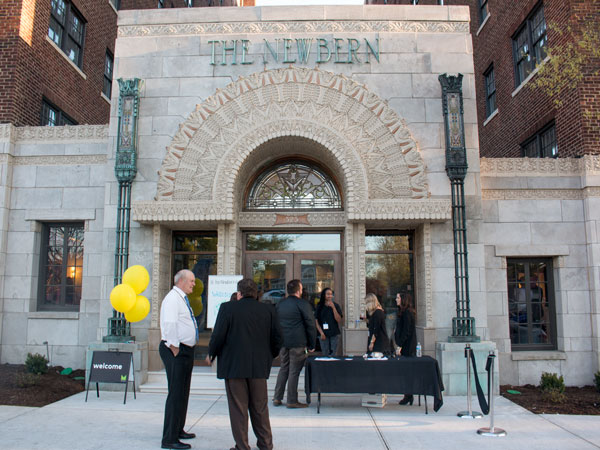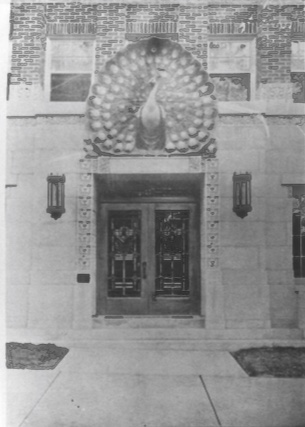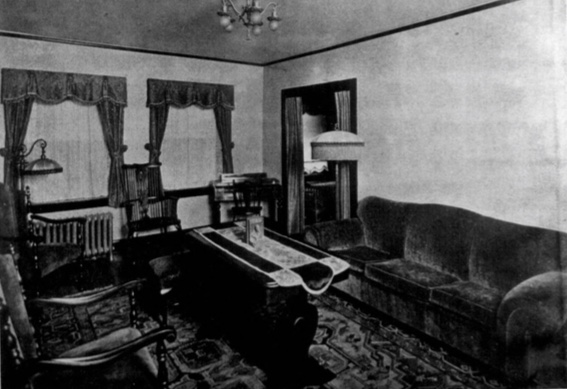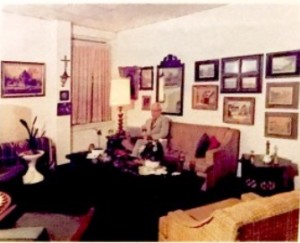
One of the former apartment hotels on Armour Boulevard, the Newbern, celebrated its grand reopening last week. The Newbern’s history tells a tale of the glory days of Armour Boulevard, its decline, and its new role as Midtown’s major apartment corridor.
MAC Properties, a developer who has renovated. ts on Armour, spent more than a year renovating the Newbern and is now renting a studio, one andseveral apartmenbedroom apartments in the building.
As part of our Uncovering History Project, the Midtown KC Post is examining each block in Midtown. A set of 1940 tax assessment photos is available for many blocks.

The original entrance to the Newbern was at the corner of Armour and Cherry in 1925 when it still sported the controversial Peacock name and image over its door.
The Newbern was built in 1921, during the period when Armour Boulevard was transitioning from a posh residential district to a street of luxury apartment hotels. It was actually two nine-story towers built by C.O. Jones, a Kansas City developer also responsible for the Bainbridge, the Walnuts, and other Kansas City apartments. Architects Brostrom & Drotts wanted the buildings to be modern rather than follow a classical style.

The apartment building was originally called the Peacock Hotel, with furnishings celebrating the colorful bird. In an advertisement in the Kansas City Star in 1922, the Peacock sang its own praises:
A favorite lunching and dining place for motorists who go up and down Armour boulevard is the beautiful tea room of the Peacock Hotel, for the Peacock is centrally located in one of the city’s most desirable residential neighborhoods.
The gorgeous appointments carry out the hotel crest. The rich peacock blue velvet curtains and tapestried overdrapes in peacock design, the exquisite china bearing the crest, the silver hollow ware richly embossed with peacocks, the softly shaded lights all go to make up an atmosphere of elegance and luxury that cannot be excelled. The best and happiest part of all this is the prices, for this service, are very reasonable and the dining room is open to the public as well as to resident guests.
By 1925, the peacock image had become controversial when Beine Hopkins bought the apartment hotel for $1.6 million. According to the hotel’s National Historic Register nomination. “The terra cotta peacocks, referred to as “unfortunate 6-foot birds” in a news article of 1925, were said to have offended some hotel guests to the point of turning them away.” Whether it was that or for another reason, Hopkins changed the name to the Newbern and removed the peacock image.

An interior view of a Newbern apartment from the 1940s.

Residents – or anyone else – could dine at the Newbern’s dining room, which this 1941 newspaper advertisement touted as famous for the cooking of “Aunt Millie Jordan.”
Over the decades, hundreds of single people, couples and families called the Newbern home. They were not the elite of Kansas City who lived in some of the other hotels and mansions on Armour but middle-class families.1930 census records offer a glimpse:
- Many of the residents were the families of salesmen who worked for various businesses, including a brick manufacturer, a printer, an oil company, a security company, a flour company, and a millinery.
- Several physicians and lawyers in general practice made their homes at the Newbern.
- George Fowler, a Methodist minister, and his wife also had rooms.
- Several people who worked in the lumber industry were residents.
- A public school art teacher, Lillian Weyl also lived at the Newbern.

A 1970s brochure for the Newbern shows a change in marketing strategy. According to the brochure, the Newbern was then offering “grandeur and charm for older adults with economical rates.” Although the apartments were not a nursing home, residents had access to a nurse on call 24 hours a day.
A decade later, the 1940 census shows little change in the types of residents who called the Newbern home. Most of the apartments were occupied by couples or single residents , including:
- Several public school teachers and a public librarian.
- Several families whose wage earners worked in the railroad industry.
- Two airline pilots.
- A special agent of the FBI.
- A cigar salesman.
Do you have memories or more details about this area of Midtown? Please share them with our readers.
Nice work! It is great to see these grand old buildings rehabilitated and reading your stories about them puts the context back in. I briefly visited Newbern a few times in the 1980s. By then, it was waaay past its prime….but now, look! New(bern) again.